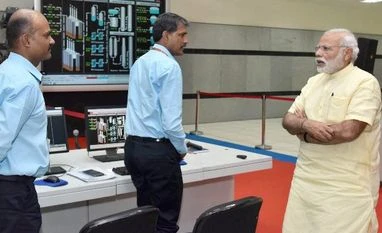A joint venture company promoted by ONGC, GAIL and GSPC, OPaL is implementing a grass root integrated petrochemical complex located within the SEZ under the Petroleum, Chemical and Petrochemical Investment Region (PCPIR) at Dahej near Bharuch.
At full capacity, the complex will annually produce 1.4 million metric tonnes of polymers such as linear low density polyethylene (LLDPE) and high density polyethylene (HDPE), polypropylene and 500,000 metric tonnes of chemicals like benzene, butadiene and pyrolysis gasoline, among others. These products are known as polyolefins, a collective description for plastics types used in various industries including consumer durables, pipes, plastic solutions, food and non-food packaging, automobiles and textile industries.
The products will be marketed under the brand name 'Opalene', with OPaL expecting to export 40 per cent of the same.
Dedicating the plant to the nation here, Modi said that in 2011-12, Dahej was ranked 23rd as a global industrial region. "The Dahej area has already seen investment worth Rs 40,000 crore by providing employment to over 120,000 people. Under the Dahej PCPIR, there is a potential to employ 32,000 people directly. When fully-functional, the area will provide employment to about 800,000 people," Modi said.
Back from Uttar Pradesh after campaigning, Modi took a dig at the opposition parties at the event. "In the recent UP election campaigning, no party questioned the government on the issue of price rise. This means that the government has been successful in keeping inflation in check," he said.
Commenting on the project, OPaL chief executive officer, K Satyanarayana said that the company would use ONGC's captive feed of C2+ streams such as ethane, propane and butane from C2-C3 Extraction plant, and naphtha from Hazira & Uran to produce polyethylene and polypropylene.
Apparently, the project, which was conceived in 2006, was delayed, leading to cost escalation. The plant was initially estimated to cost around Rs 12440 crore which ultimately escalated to Rs 30,000 crore.
"We have invested about Rs 30,000 crore for the project with a combination of debt of Rs 19,000 crore and equity Rs 11,000 crore. Once operational at the full capacity, we expect the plant to generate a revenue of Rs 16,000 crore per annum," Satyanarayana said.
Going forward, the project will generate further investment of Rs 40,000 crore through growth in plastic processing industries and over 20,000 indirect employment opportunities, OPaL stated.
The plant will generate direct employment for 3,500 personnel and indirect employment for around 10,500 people.
Commenting on the stake sale plans of the company, Satyanarayana stated that the talks are on with the Kuwait-based energy player PIC, an arm of Kuwait Petroleum Corporation (KPC). "We are ready to offer as much as 40 per cent to the new partner. However, the talks have been on for about 1.5 years but nothing has been finalised as yet," he added.
Having its operations in a Special Economic Zone, the company plans to focus on exports, which has already started with first consignment of Butadiene supplied by the company. "We expect to achieve full capacity in the next four months. The planned capacity of the facility is 1.9 million tonnes. However, we will also sell part of our products to the domestic market," he added.
ONGC holds 26 per cent stake in OPaL, followed by nine per cent by GAIL and 0.2 per cent by GSPC for the Rs 11000 crore equity infused into the project.
OPaL projects its market share in the polymer sector to be at 13 per cent by 2018, even as it anticipates its products to be used for sectors like infrastructure, housing, packaging, irrigation, automotive, and healthcare.
Currently, the average per capita consumption of polymers in India is 10 kg, as against a world average of 32 kg. In the last decade, the petrochemical sector in the country has grown by 10-12 per cent per annum, even as it is expected to grow at a rate of 12-15 per cent in the next decade.
To read the full story, Subscribe Now at just Rs 249 a month
Already a subscriber? Log in
Subscribe To BS Premium
₹249
Renews automatically
₹1699₹1999
Opt for auto renewal and save Rs. 300 Renews automatically
₹1999
What you get on BS Premium?
-
Unlock 30+ premium stories daily hand-picked by our editors, across devices on browser and app.
-
Pick your 5 favourite companies, get a daily email with all news updates on them.
Full access to our intuitive epaper - clip, save, share articles from any device; newspaper archives from 2006.
Preferential invites to Business Standard events.
Curated newsletters on markets, personal finance, policy & politics, start-ups, technology, and more.
Need More Information - write to us at assist@bsmail.in
)